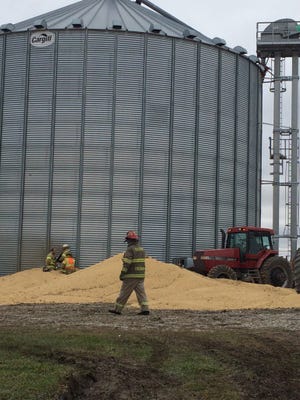Grain handling safety more important than ever

Marshfield, WI — The recent death of a 16-year-old South Dakota boy in a grain bin incident is a grim reminder of the hazards of grain handling.
“Tragedies like this motivate safety people to work even harder,” said Marsha Salzwedel, M.S., Agricultural Youth Safety Specialist with the National Children’s Center for Rural and Agricultural Health and Safety, part of Marshfield Clinic Research Foundation, Marshfield, WI.
On the same day that Salzwedel presented a grain handling safety talk in Indianapolis during the National FFA Convention, Taylor Watzel, an FFA student from Winner, SD, became trapped in a grain bin. He died from his injuries the next day, Oct. 19.
“If we can get people to use these resources, we can prevent incidents like the one with Taylor from happening in the future,” Salzwedel added.
Working in and around grain is known to be extremely dangerous, even for adults, Salzwedel stressed. For youth, special care needs to be taken, as they are particularly vulnerable to workplace hazards.
"Their desire to please others and appear knowledgeable and mature often prevents them from asking questions or seeking help," she said.
To help safeguard youth who are working around grain, the National Children’s Center partnered with the Grain Handling Safety Coalition to develop safety resources and guidelines, as well as curriculum designed for high school agricultural classes and community training. All resources and curriculum are free to download and use.
Guidelines for youth working around grain
- Youth are not working in or around grain storage structures or wagons when grain is being loaded, unloaded or transferred
- When working in empty grain storage structures, all safety procedures, including lock-out/tag-out are followed.
- Youth are fully trained on the job to be performed, including proper climbing techniques, and on the personal protective equipment used
“The work guidelines can be used in supervised agricultural experiences or by anyone supervising young workers to determine if a youth is able to perform a job safely,” Salzwedel said. “When working with grain, adding the curriculum enhances youth safety. We want to educate youth about flowing grain hazards, but we also want the adults supervising the youth to make sure the young people are doing age appropriate work.”
The grain safety curriculum is a full set of curriculum, which has been correlated to the ANFR standards. Currently, the “Entrapment, Engulfment and Entanglement” module is available. Two more modules will be coming soon. All modules include: PowerPoint® presentations, interactive activities, instructor guide and notes, student note pages
Quizzes, pre & post tests and evaluations along with additional resources.
For more information and to access the free resources and curriculum, visit http://grainsafety.org/young-workers/. To access youth agricultural work guidelines, visit: https://cultivatesafety.org/work-guidelines/.
Salzwedel and Education Outreach Specialist Tammy Ellis staffed the National Farm Medicine Center exhibit at the convention, where they engaged more than 2,700 students and FFA advisers, discussing safety resources and strategies that prevent agricultural injuries and fatalities.